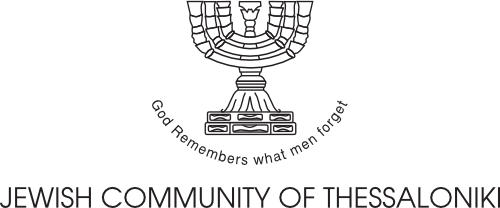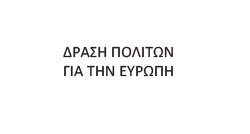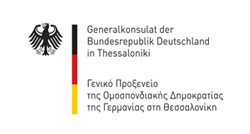“Violence against civilian population:martyred villages„
Introduction
Each generation "re-writes" history from its own perspective, which may differ every time. The younger generations perceive the past differently than previous generations and that's because the present shapes our perspective of the past. Through history classes, students learn that the past is directly related to their lives and their future. The development of historical thinking and the cultivation of historical consciousness (which consist of basic aims of history education) create the necessary conditions for responsible, active and conscious citizens.
How can and why should an issue such as the massive retaliations during the Nazi Occupation contribute to the development of the democratic consciousness of the students? These are traumatic and controversial historical events which often pose controversial historical issues for local communities with political sensitivities, triggering strong emotions. However, such a historical issue has to be updated, by highlighting certain modern issues and concerns, such as (a) the rise of the extreme right, the popularity of organizations with pro-Nazi practices and policies, the intensity of the phenomena of violence, xenophobia and racism, or (b) the fierce anti-German sentiment arising from the current economic and political conditions in Greece –analogies to the inhuman conditions of the Occupation are often drawn, bringing back traumatic memories and putting the blame on current day Germany, thus strengthening ethnocentric convictions.
In this teaching scenario we choose to approach aspects of World War II according to the disastrous consequences of the war for the whole of humanity. We focus on cases of martyred towns and villages in the period 1941-1944, where the practice of retaliation and, in particular, violence against the civilian population peaked, and try to detect the ideological, social or psychological mechanisms that led many people to criminal acts. Our interest in the local does not in any way reduce the importance of a broader perspective or trap us in a dipole of abuser-victim with ethnocentric features. We are simply posing the question what breeds violence and prejudice, why was there so much violence and how can we protect humanity from it in the future, with the prospect of reconciliation with the past and the "Other", as well as the development of a critical attitude towards totalitarian ideologies.
The sources of oral history are those that humanise history and give "voice" to everyday people who have experienced historical events, thus illuminating multiple and alternative versions of history. The primary sources and especially the witness accounts as sources of lived experience allow for a deeper understanding of the past, for the exploration of individual and collective memory and the enhancement of historical empathy and multiperspectivity. They must be used responsibly, prudently and with deep awareness of the fact that they are emotionally and ideologically loaded, as well as of their particular characteristics. Secondary sources, such as literature and film, play an important part in this approach, and often carry the historical context and the atmosphere of the time, the psychographic characteristics of people and their ethical dilemmas, thus contributing to a deeper historical understanding. The narration and representation of trauma in art, with a variety of means and ways, serves as a kind of release and redemption, or even a form of wound healing.
In this work the material is very limited and only indicative, as the majority of the content is in the Greek language (witness accounts, literature, articles etc.), as are the suggestions for their educational use. Here, it is listed more as informative material.
Main Body
Map
- On the map are marked the locations of martyred towns and villages (grouped per year).
- Timeline: Black Book of Occupation, 2nd edition, Athens 2006 (greek and german), p. 60-91.
- Historiography: Hermann Frank Meyer website (ελληνικά, english, deutsch)
Nazi logic
- The imposition of German power, The Second World War, Foundation of the Hellenic World.
- The logic of violence and terrorism
“The enemy has brought into the guerrilla war fanatical fighters who have been trained by the communists and do not refrain from any act of violence. What is happening here is more than just struggle for survival. This conflict has nothing to do with military honour, or the Geneva Conventions. Unless this fight against guerrillas in the East and in the Balkans is conducted with the fiercest means, in the near future our forces may not be sufficient to impose on this terror. This is why the units have the permission and order to not hold back in this fight, to make no exceptions for women or children, if these measures are necessary for success. Any kind of [humanistic] reservations constitute a crime against the German nation…”
Orders of Marshal Keitel (based on Hitler's orders), 16 December 1942
From the introduction of the Third Part of "The logic of violence and terrorism: 1943-1944" (p. 179) by Mark Mazower (1994). Inside Hitler’s Greece: the Experience of Occupation / trans. Costas Kouremenos. Athens: Alexandria, 181-290.
Wilhelm Keitel (Wilhelm Bodewin Johann Gustav Keitel) was Marshal of the Third Reich and head of the High Command of the German Armed Forces (Wehrmacht). He was Hitler’s right hand as far as military matters were concerned. - Extract from the article The Symplegades of Nazi logic by Hagen Fleischer, (from the special issue of the newspaper Kathimerini, SEVEN DAYS, 14.11.1999).
[...] In what concerns the fight against the Resistance, the Germans hardened their stance after the Italian surrender in September 1943. At the same time, they were trying to systematically deepen and broaden the (political and state) rivalries inside Greece. Their decision, at the end of 1943, to establish the Security Battalions, stemmed from the desire to “save precious German blood”. [...]
In the 'cleansing' missions the rural population was crushed between the Symplegades of Nazi logic: On the one hand, their fleeing at the appearance of German troops was considered proof of guilt which justified and required punishment; on the other hand, remaining in the villages carried, at least for the men, the danger of being arrested as a “preventive” measure and transferred to a hostage camp or being executed immediately as “retaliation” for some Resistance attack somewhere in the area. Units of Wehrmacht or SS annihilated hundreds of villages and towns, exhibiting immense fury especially in Komeno, Lygiades, Kalavryta, Kleisoura, Distomo, Anogia and Chortiatis, but also in other, less well-known areas. According to (incomplete) German documents, only for the period June 1943-September 1944, the enemy losses (in attacks and "retaliation") amounted to 25.435 dead Greeks and 25.728 arrested. Among the latter, many were sent to the Reich concentration camps, even at the eve of liberation, and a large number of them never returned. Others were “consumed”, according to Nazi terminology, as hostages or ended up in prisons and camps, the most notorious of them being the one in Haidari. These numbers, after all, did not include the (many more) dead due to starvation, the unborn children, or the 60.000 murdered Greek Jews - 83% of all Greek Jews - victims of the unfathomable racial hatred of the Nazi regime and its spineless subjects.
As for the material destruction of Greece, we must mention the sinking of 73% of the commercial fleet, the squandering of the drachma, the annihilation of forests, as well as of the road and rail infrastructure - which was permanently and systematically dismantled during the German withdrawal from mainland Greece in October 1944. As platoons were going on a rampage throughout the country, the commander of Wehrmacht in Greece was “bidding the people of Athens farewell” with the claim that during the Occupation, the German services were constantly... “struggling to keep hunger and misery at bay and to support the economic and cultural life of the country” [...]
Videos
- Documentary Neo-Nazi: The Holocaust of Memory by Stelios Kouloglou
“A documentary within a documentary about memory and oblivion”. It explores historical truth in current Greece, through the eyes of students of a school in the Greek village Distomo. The film provides shocking evidence of the atrocities that took place in two Greek villages perpetrated by the German nazi army and their Greek collaborators who want to take revenge for the defeat of Nazism, 70 years ago. It revisits Greece’s path from German occupation during World War II to the rise of Golden Dawn, an extreme right party. The documentary shows that young people in Greece seem to be unfamiliar with this subject and suggests that this ignorance is related with the growth of Golden Dawn. - Trailer of the film “The chronicle of a disaster” by Chrysa Tzelepi and Akis Kersanidis. A film about the incidents that took place in Chortiatis and led to its annihilation in 2/09/1944.
- Trailer of the film “A song for Argyris” by Stefan Haupt.
“Distomo: a small farming village at a stone’s throw from the sea, on the road leading from Athens to Delphi. This is where little Argyris, who was not even four years old, survived a brutal massacre committed by the German occupying forces on June 10, 1944. An SS division’s so-called “expiatory measure” after a partisan attack in the vicinity. Within less than two hours, 218 villagers were killed: women, men, elderly people, toddlers, and babies. Argyris lost his parents and thirty more relatives”.
Source: fontanafilm. For further information here.
60 years have passed since that day in June.
A child is robbed of its parents.
The monstrosity of war.
How does one live with such a past?
Accept it? Resist it? Bring a charge?
(director’s thoughts on the film)
Witness accounts
- Audio-visual archive from the Municipal Museum of the Holocaust in Kalavryta
Testimonies by the survivors of the disaster in Kalavryta. - “A witness account of the disaster in Chortiatis”, 02/09/2013, TVXS. Extract from an interview with Eleni Nanakoudi.
Journalist (D): First of all, how old were you?
Nanakoudis HELEN (N.E.): I was ten, ten and a half.
[...] We didn’t know what was coming; we did not expect such a thing, no. On that day, rebels descended from the mountains and attacked a German. One was killed, another was wounded, and then they left. The Germans sent word to Asvestochori, they had reinforcements over there, Germans and Greeks alike, and they came to the village. We had no idea, we were sitting at home, the Germans came, they knocked on the door, we opened up, and they gathered us, all the women and children they found. I was with my mother and sister, they took us to the yard [...] in Bantatsio, a venue that was there. [...] Greeks were cursing us there. When I say Greeks, I mean collaborators of the Germans. [...] many of us were asking what would happen, what they’d do to us. Three boys came crying. The women asked them why they were crying and they replied because they killed our mom in the yard, they cut off her fingers, they took her rings and then they killed her. Then we realized what was going to happen to us.
D: How many people were you?
N.E .: We must have been around seventy people. They put us in rows of three. We heard them wondering "where are we going to execute them." "We’ll put them in the bakery, the house is large, they should fit," someone said.
D: Were you listening to all this?
N.E.: Sure, I was listening. Once I heard what they had said I clung to my sister's neck and told her they would kill us. "Not you," she said, "just us, adults, they don’t kill children" my sister told me. Twenty years old, she was. They opened the doors, they put us in the bakery, those of us who were in the first rows, we climbed onto the kneading area. We were told to sit down. We sat down, they set up a machine gun at the front door, in the kneading area and began shooting at us. My mom was killed first, then my sister, then they started bringing in stacks of grass and throwing them on us. They set them on fire. I saw a lady climbing down with a baby in her arms, and I followed behind her. Everyone there was dead and the ground was filled with corpses. This lady walked to the door to get out, but then some men emerged in front of her, Tagmatasfalites (men of the Security Batallions) I’d say, and I heard them saying "where is the lady going?" and they stabbed her... She fell in front of the door, but as I was small they didn’t see me behind her. I got under the worktop and they didn’t see me. After a while I came out. It was quiet in the yard and I heard conversations on the road. Where could I go? There were several dead in the yard as well, we couldn’t all fit in the bakery, so they had killed all the others in the yard; I fell face down on top of the corpses and played dead. I stayed there for a while, there was a woman beside me, her baby was suckling her. She was dead and the baby was suckling. It would cry and suckle, and the tagmatasfalites came and saw the baby and they started laughing because it was suckling its mother. Meanwhile, the woman was still bleeding. All the blood was spilling on me, but we didn’t make a sound. None of us. They started kicking us to see if there was anyone alive, but they couldn’t tell because people were still dying and they couldn’t understand who was alive and who were dead. I waited there a bit. It started getting dark, the house, the door started burning. [...] [...]
D: That was in '44?
N.E .: In '44; soon after the Germans left, but we were meant to suffer this madness. [...] - Extract from the testimony of Nikos Kazantzakis as a member of the Central Committee for the Verification of Atrocities in Crete (K.E.D.O.K.), founded on June 17, 1945 in order to record the killings and destruction in every village of Crete. Nikos Kazantzakis is one of the most important Greek writers and the most translated one.
"Most villages in Crete were utterly destroyed; most men were killed because they helped the English. In a village, Meskla, I saw a mother who had lost her two sons because she had hid two British soldiers in her house for nine months. The Germans found out, so they burned the house and killed her sons, and now she as standing in front of the rubble slender, bereaved, with flaming eyes, and was talking to me. -The same night that my sons were killed two Englishmen came by, that were being hunted by those dogs, the Germans. The house was still burning, but I had hid in a corner and I was crying. The English heard me and came near. Bread, they were crying, bread! The villagers had given me a loaf of barley bread, but I had no appetite, nothing would go down. I gave them the bread. They were cold, so I gave them a blanket the other villagers had given me, I came out, made them a place to sleep. -Why did you do all this? I asked. Was it not because of the Englishmen that your sons were killed? -I did it, she replied, because they had mothers, too, and I know how fierce a mother’s pain is. This was a great act of compassion, the human soul overcomes individual pain, even the most terrible one. I was listening to the old woman and weeping."
Photo Galllery
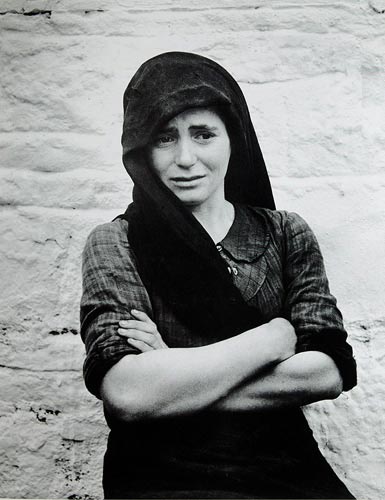
Maria Pantiska. Photo by Dmitri Kessel, published in LIFE magazine on November 27, 1944. You can find the issue here. You can find more photos here.
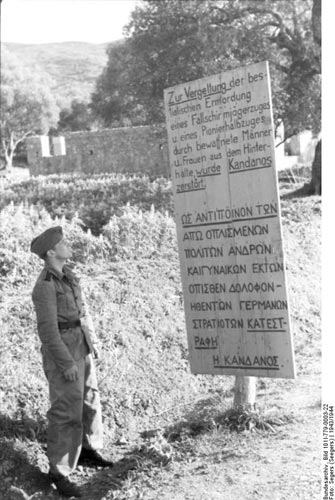
Photo from the German Federal Archive of a sign from 1943 in Greek and German: “KANDANOS WAS DESTROYED AS RETALIATION FOR THE MURDER OF GERMAN SOLDIERS BY ARMED MALE AND FEMALE CITIZENS”. Source: Wikimedia Commons

“The school of Chortiatis before it was destroyed”
Source: Theodoros Valahas & Dafni Theohari (2008). September 2, 1944, Chortiatis: All that is left from that day is memory. Thessaloniki: Chortiatis 570, p. 161.
Art
“Kalavryta, The Execution”
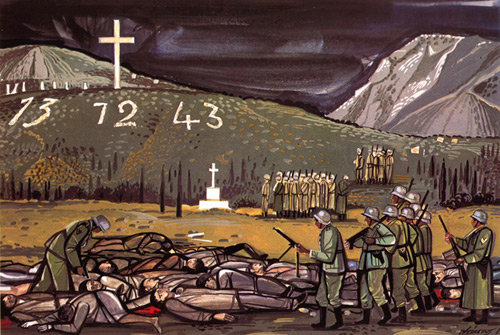
Tassos(Laevizos), colour tempera 29x42, 1985. Source: Artistic memories, Museum of the Holocaust in Kalavryta.
“Slaughters in Distomo”
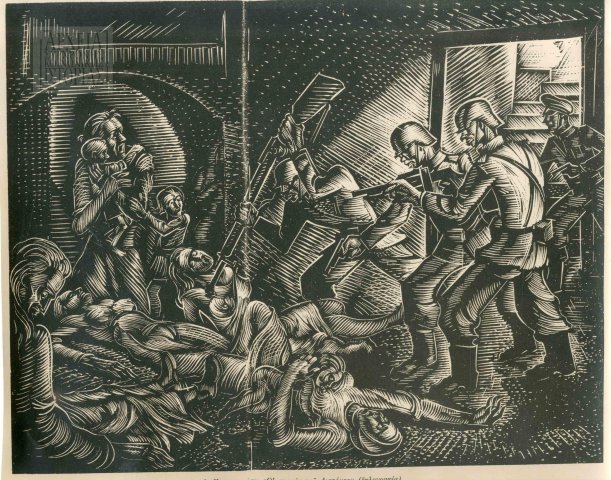
Alexandros Korogiannakis, block print, 1944. Source: Exhibits from the Contemporary Social History Archives: Memories from the Occupation and the antifascist struggle.
“No more wars”
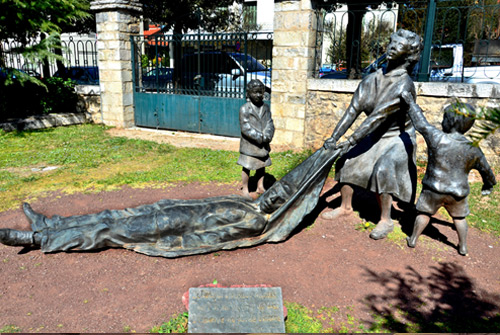
Sculpture - composition, a work by the sculptor Nikos Dimopoulos exhibited in the yard of the Museum of the Holocaust in Kalavryta. Source: Sp. Salamouras via wikipedia
Music
“The mountains weep, they mourn”
The song was written by Vaggelis Soukas. The song was recorded in Columbia, in 1961, sung by Koula Dinou.
Lyrics: The mountains weep, they mourn, the meadows grieve and a bird laments by the river of Arta,
What’s wrong little bird, why are you sad and crying, lamenting and withering with sorrow?
Bleak years have come, that’s why I’m sad, they’re slaughtering Kalavryta, Distomo and Komeno
Source: “Martyred Komeno” website
(The painting featured in the video was painted with coal by Agisilaos Kyriazis and was inspired by the martyred village Komeno, in Arta).
“Songs for Kommeno”
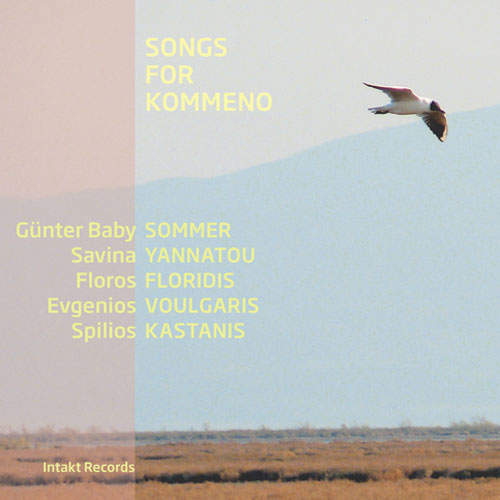
This album is the result of a Greek-German collaboration and it has been inspired by the Nazi atrocities imposed on the village Komeno, in Arta, in August 16, 1943. The renowned percussionist Günter “Baby” Sommer, Floros Floridis, Evgenios Voulgaris, Spilios Kastanis and Savina Yannatou collaborated on this album.
You can listen to the record here or here .
Read an interview with Günter Baby Sommer




